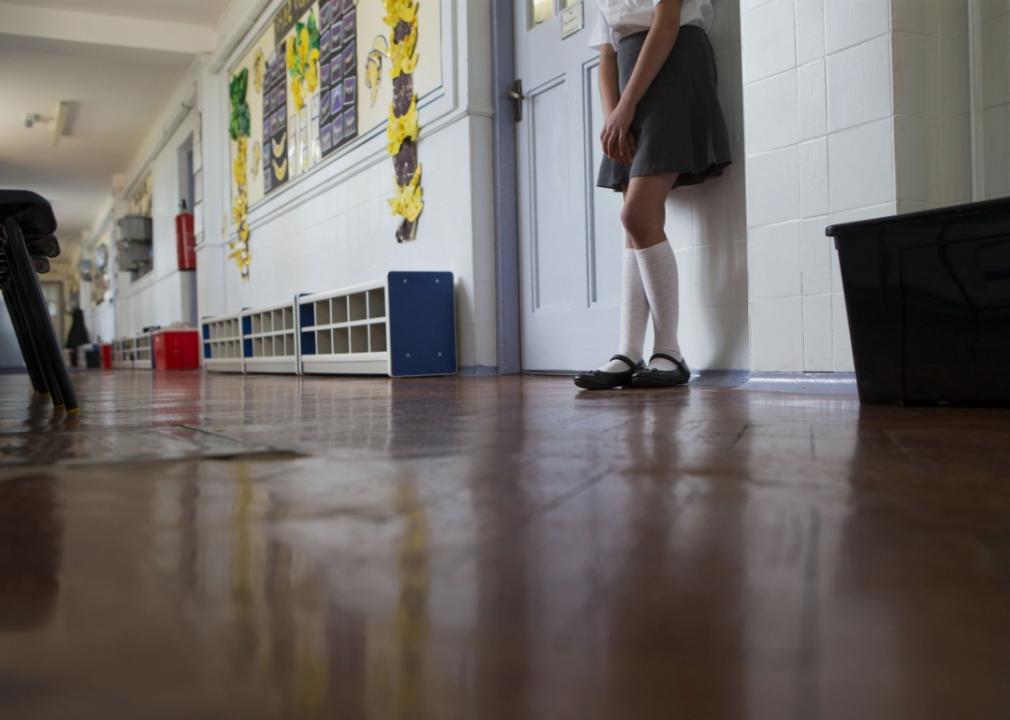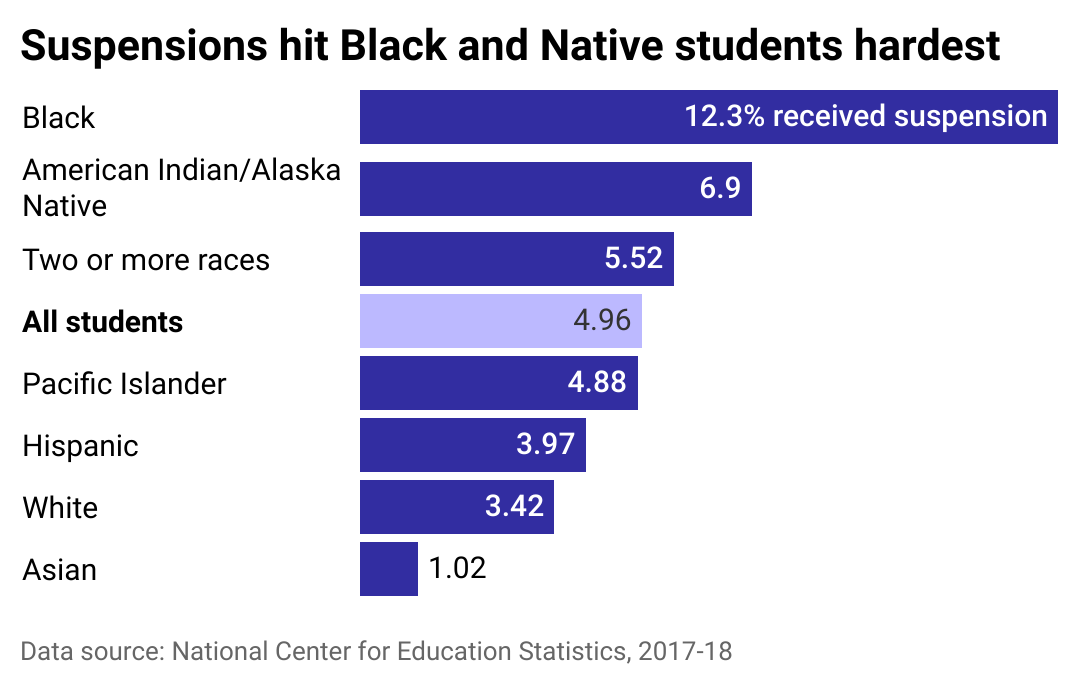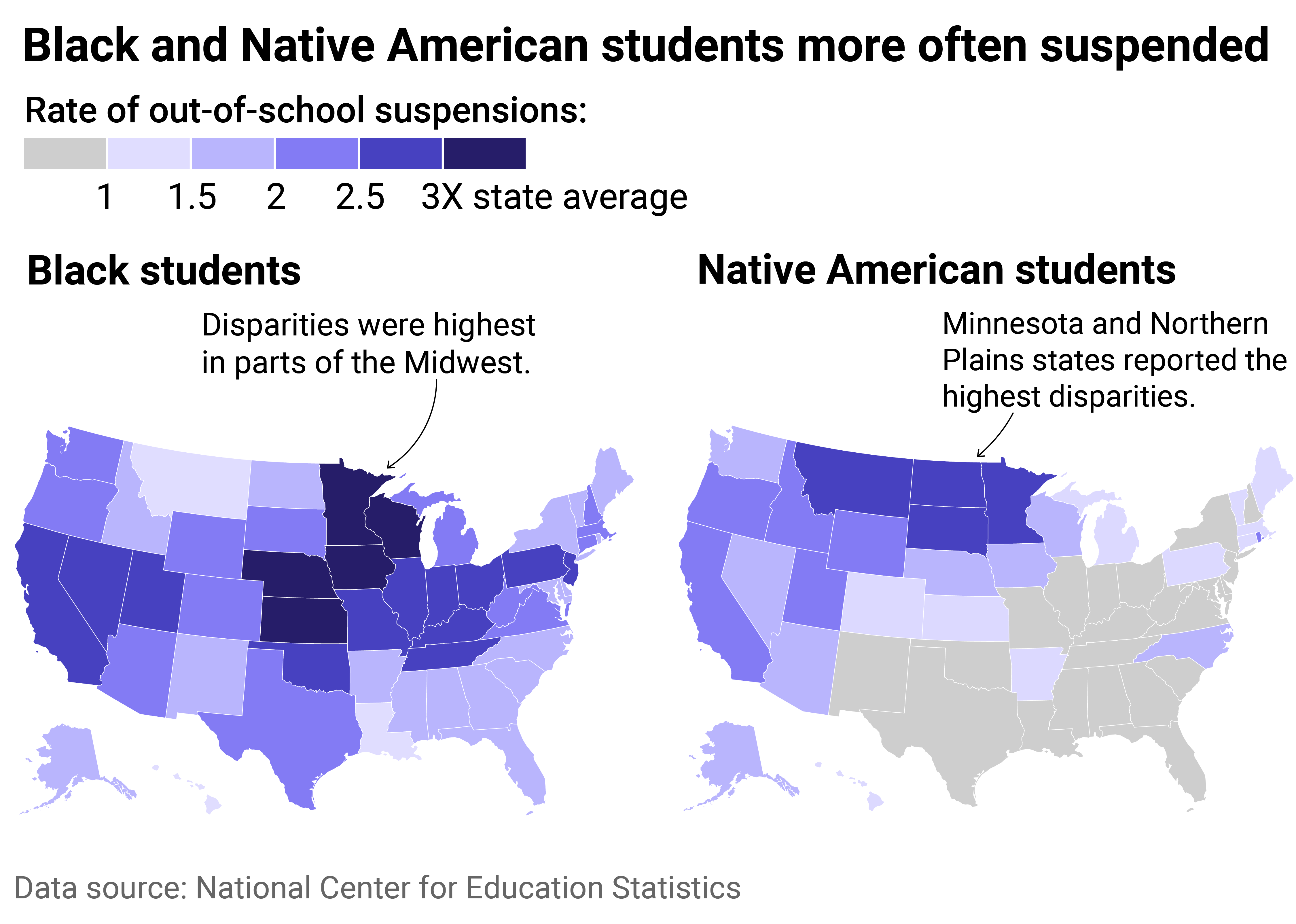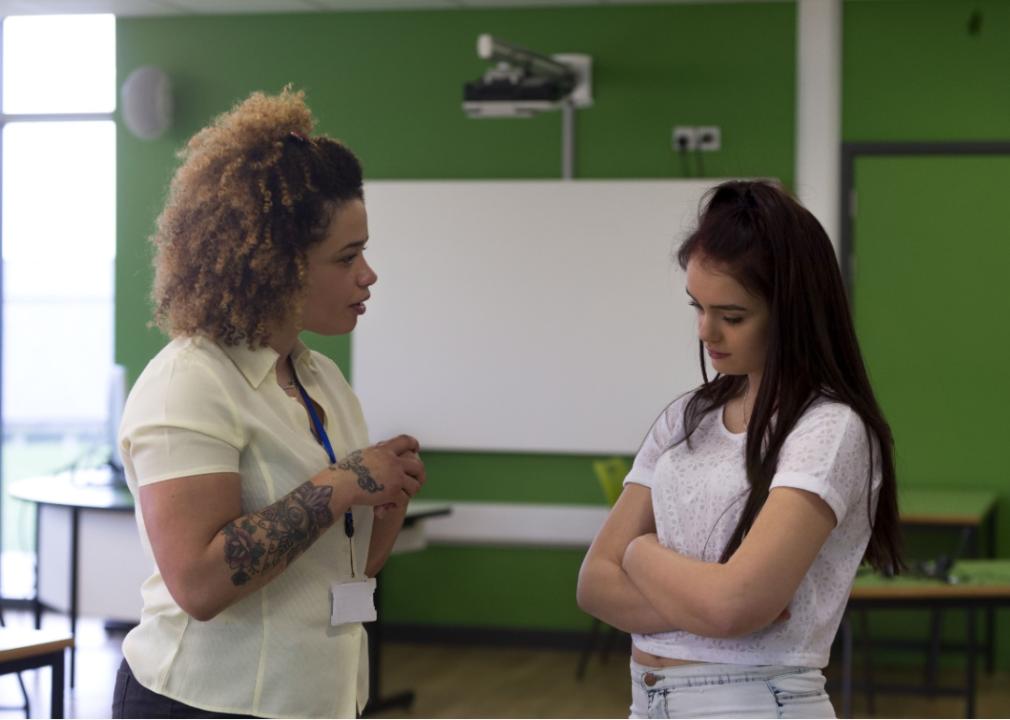Out-of-school suspensions can do more harm than good, data shows

Shutterstock // DGLimages
Out-of-school suspensions can do more harm than good, data shows
A close-up shot of a young female student’s lower torso and legs. She is wearing a grey skirt, long white socks as she leans against a classroom door, standing in a school corridor.
Concerned that out-of-school suspensions disproportionately target Black and brown students and stifle learning, some U.S. schools are doing away with this disciplinary practice.
Using data from the National Center for Education Statistics and other sources, Study.com examined the racial disparities of out-of-school suspensions and why some schools are opting out of this discipline. Because of the impact of the COVID-19 pandemic, this analysis used data from 2017 to 2018.
The debate about how to discipline America’s school children is as old as the founding of this country. In the 1700s school teachers disciplined students via corporal punishment (think switches or rulers), a practice that by the 1840s was harshly criticized by educational reformer and “father of public education” Horace Mann. By the 1950s, teachers unions agreed their contracts should reflect a focus on education instead of behavior and no longer doled out classroom punishments. Instead, principals, social workers, and administrators disciplined students.
However, the “war on drugs” of the 1980s and 1990s ushered in a rise in zero-tolerance policies in schools and by on-campus police officers. Initially, zero-tolerance measures required students who committed certain infractions to face out-of-school suspension or expulsion, regardless of individual circumstances or the severity of the alleged offenses.
For example, the 1994 Gun-Free Schools Act mandated that public schools expel students for at least one year if found with a firearm on campus. This law codified zero-tolerance policies, which eventually expanded to strict punishments for various offenses, including fighting and “defiance,” according to an NBC report. “With the advance of zero tolerance, Black children experienced a 9-point increase in suspension rates, from 6% in 1973 to 15% in 2006,” details a 2010 Southern Poverty Law Center investigation on urban middle schools. In contrast, the white student suspension rate grew by fewer than 2 percentage points.
National data for 2020 shows that 1 in 6 students in K-12 public schools were Black, but they were twice as likely than white students to get a suspension or to be expelled from school. Although American Indian/Alaska Native students made up only 1% of the K-12 school enrollment, they represented 2% of the overall student body referred to law enforcement and subjected to school arrests.
Also troubling is the long-lasting negative effect that these discipline measures have on the educational trajectory of students.
For example, students with suspensions lasting more than 20 days were less likely to graduate from high school on time, according to the American Institutes for Research. The paper also notes that high school students who received an out-of-school suspension instead of an in-school suspension were less likely to earn an English language arts and math credit the following year. Even more worrisome, according to the American Civil Liberties Union, suspended or expelled students are three times more likely to become part of the juvenile system.
![]()

Study.com
Racial disparities underscore suspensions
Bar chart showing suspensions hit Black and Native students hardest. 12.3% of Black students received suspensions and 6.9% of American Indian/Alaska Native students, compared to 5% on average.
Race is one of the biggest, if not the biggest, predictor of whether a student gets suspended, particularly in schools that overly rely on harsh disciplinary actions. Schools suspend Black students at much higher rates than white and Asian students, according to a targeted study in 12 schools in an urban Mid-Atlantic school district published in the American Psychologist 2021.
Researchers found that over three years, 1 in 4 Black students in these schools received at least one suspension for a minor infraction compared with just 2% of the white students. This treatment often stems from implicit biases by educators, who might perceive and interpret behaviors differently based on a student’s race. Behaviors that might be perceived as minor mischief in white students could be viewed as aggressive in Black students. The perception gap results in harsher penalties for the same actions, reinforcing negative stereotypes with potentially life-altering outcomes.
“What we need are interventions that look at both a reduction in overall use of exclusionary discipline, but also focus on issues of implicit bias [and] structural racism,” Russell Skiba, professor emeritus at Indiana University who focuses on education equity, told ScienceNews.
Black students do have lower rates of suspensions and better educational outcomes when they have a Black teacher; unfortunately, despite increasing diversity since 1990, 80% of K-12 teachers are white.

Study.com
The scale of disparities varies across states
State map showing every state reported higher suspension rates for Black students compared to the state average. Disparities were highest in parts of the Midwest. For Native American students, 28 states reported higher suspension rates, with Minnesota and Northern Plains States reporting the worst disparities.
Black and American Indian Alaska Native students in the Midwest face significantly higher suspension rates than their peers.
Wisconsin, home of Milwaukee, has the highest rate in the nation of school suspension for Black students—4.23 times than the state average. Nebraska follows closely, with Black students suspended at 3.8 times the state average and Iowa at 3.72 times.
Black students made up nearly 80% of suspensions in Milwaukee public schools, according to 2023-2024 school year data. That is, out of the 15,739 students suspended by the school system, 12,456 were Black, 2,274 Hispanic, 101 American Indian, 191 Asian, and 388 white. Black students make up half of the students in the Milwaukee school system; 1 in 4 are Hispanic and 1 in 10 are white.
The school district gives monthly suspension updates after a federal investigation discovered that the Milwaukee school expelled and suspended Black students disproportionately. When it comes to the school-to-prison pipeline, Black students in Milwaukee also face the brunt of referrals to law enforcement at 84.6%. In general, Wisconsin has the highest rate of incarceration of Black people in the U.S.—1 out of 36 Black adults are in prison—according to The Sentencing Project.
For American Indian and Alaska Native students, North Dakota reports the highest suspension rate, 2.94 times the state average. Only 10% of the students are Native American, yet they represent a third of all out-of-school suspensions and 1 in 4 of all referrals to law enforcement, according to data from North Dakota KIDS COUNT, which focuses on the well-being of the state’s children. North Dakota’s disciplinary policies have shifted from corporal punishment to zero-tolerance but has yet to largely adopt restorative justice practices.
Montana and Minnesota also show significant disparities, each with suspension rates at about 2.7 times the state average for American Indian and Alaska Native students.
In Hawaii, Pacific Islander students experienced suspension at 1.7 times the state average. During the 2015-16 academic year, Native Hawaiian and Pacific Islander students made up one-third of the Hawaii public school student body but also represented nearly half of suspensions, more than two-thirds of expulsions, and nearly half of school-based referrals to law enforcement, according to the Department of Education’s Civil Rights Data Collection examined by the ACLU.

Shutterstock // DGLimages
Schools explore methods beyond exclusion
A teenage girl stands with her arms crossed, facing a female teacher who is looking at her. The student has her gaze directed downward.
In response to these dismal statistics, some school districts are focusing more on conflict resolution, in-person interventions, and other methods of correction than suspensions.
An EdWeek Research Center survey found that almost half of educators reported that their districts or schools use restorative justice more than they did five years ago: 35% said that their schools use expulsions less and 44% said that their schools use out-of-school suspensions less.
The numbers are optimistic, but as Allison Payne, chair of the Department of Sociology and Criminology at Villanova University points out, the purest form of restorative justice is hard to come by. “It requires a complete overhaul of not just the disciplinary structure but the full ethos of a school,” she told EdWeek. Many schools often use restorative justice practices alongside punitive consequences causing confusion among students. Nevertheless, it is a start.
Last year, Nebraska passed a law banning suspensions for pre-kindergarten to second grade.
The only exception is if a student brings a deadly weapon to school. The ban has had mixed results. Some teachers complained that they were not given alternative discipline guidance. For example, when a student in Omaha slapped an instructional aide in the face, they returned to the classroom hours later. Now, a state legislative bill allowing schools to suspend young students who turn violent and harm people is pending.
Portland Public Schools altered its suspension policy, agreeing to use therapists, psychologists, and school counselors to help students thrive.
Oakland Unified School District uses restorative justice for discipline using “circle-of-trust” interventions that bring all parties together to resolve conflicts. In addition, in 2020, the school board voted to eliminate police presence from Oakland schools, diverting its $6 million policing budget for new safety protocols and programs to curb the school-to-prison mentality.
In 2023, California banned middle and high school students from being suspended for “willful defiance,” a subjective low-level infraction. Willful defiance could mean refusing to remove a hat or drumming on a desk.
According to data from the California Department of Education, by the end of the 2021-22 school year, Black students accounted for 14% of willful defiance suspensions despite only comprising 5% of the statewide student population. Latino students were also overrepresented. Specifically, although 1 in 3 school boys were Latino, close to half accounted for willful defiance suspensions.
Under the ban, teachers can remove students from a class for unruly behavior but are not allowed to request a suspension. Instead, the school administrator must figure out the best support or in-school intervention for the student.
In response to implicit bias, Jason Okonofu, psychologist and professor at the University of California-Berkeley, developed a three-part empathetic discipline technique that involves viewing misbehavior not as an indictment of character but as an opportunity for learning and growth, often recognizing misbehavior as a cry for help. The intervention also calls on teachers to build stronger bonds with their students and encourages them to get a better perspective by asking what their students are experiencing rather than making suppositions. Research on this intervention shows a reduction of racial disparities in suspension by as much as 50%.
Whatever the form of alternative discipline, schools will treat future generations less like criminals and more like complex human beings. Certainly, Horace Mann would be pleased.
Story editing by Carren Jao. Additional editing by Kelly Glass. Copy editing by Sofia Jarrin.
This story originally appeared on Study.com and was produced and
distributed in partnership with Stacker Studio.